ECU NISSAN VERSA SEDAN 2020 Owner´s Manual
[x] Cancel search | Manufacturer: NISSAN, Model Year: 2020, Model line: VERSA SEDAN, Model: NISSAN VERSA SEDAN 2020Pages: 492, PDF Size: 6.12 MB
Page 449 of 492
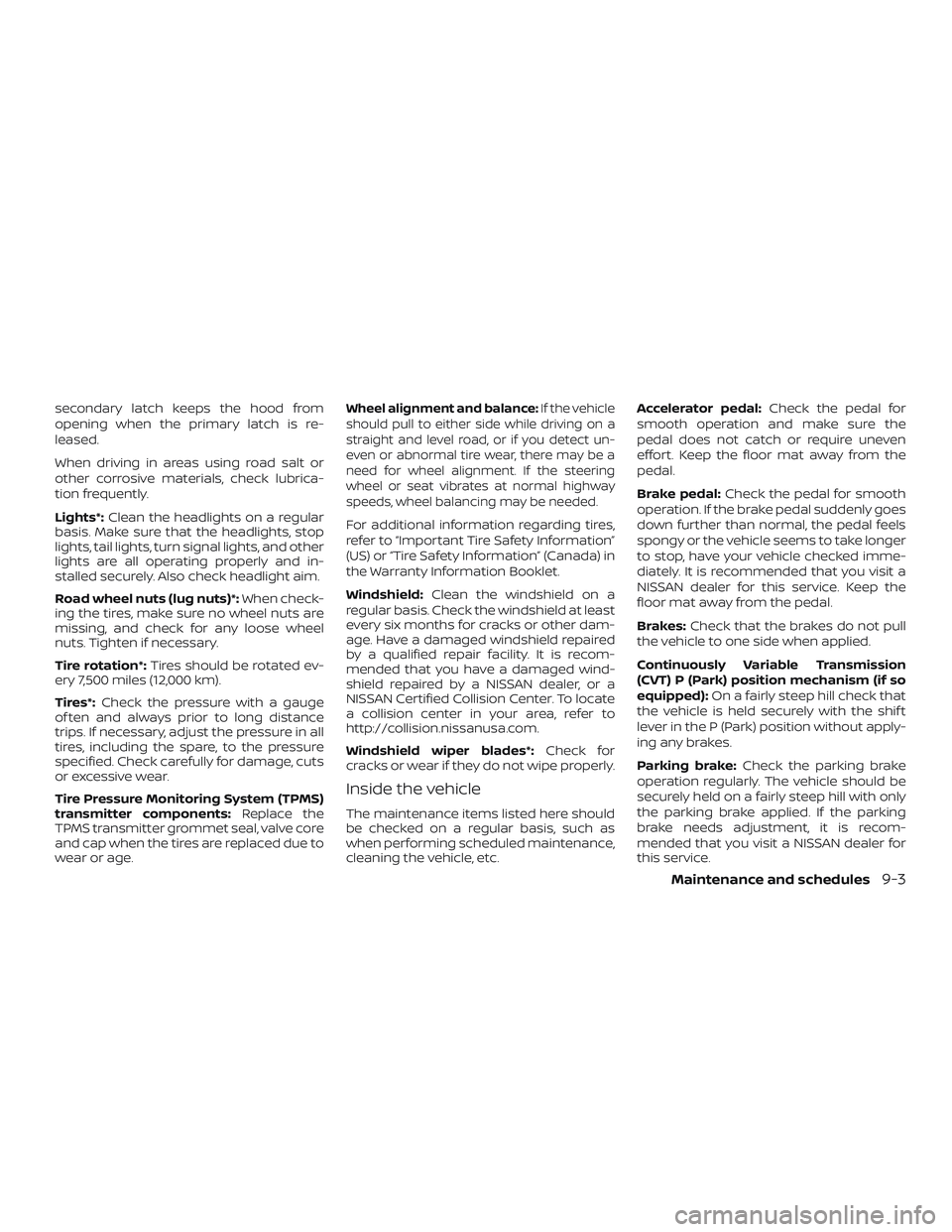
secondary latch keeps the hood from
opening when the primary latch is re-
leased.
When driving in areas using road salt or
other corrosive materials, check lubrica-
tion frequently.
Lights*:Clean the headlights on a regular
basis. Make sure that the headlights, stop
lights, tail lights, turn signal lights, and other
lights are all operating properly and in-
stalled securely. Also check headlight aim.
Road wheel nuts (lug nuts)*: When check-
ing the tires, make sure no wheel nuts are
missing, and check for any loose wheel
nuts. Tighten if necessary.
Tire rotation*: Tires should be rotated ev-
ery 7,500 miles (12,000 km).
Tires*: Check the pressure with a gauge
of ten and always prior to long distance
trips. If necessary, adjust the pressure in all
tires, including the spare, to the pressure
specified. Check carefully for damage, cuts
or excessive wear.
Tire Pressure Monitoring System (TPMS)
transmitter components: Replace the
TPMS transmitter grommet seal, valve core
and cap when the tires are replaced due to
wear or age.Wheel alignment and balance: If the vehicle
should pull to either side while driving on a
straight and level road, or if you detect un-
even or abnormal tire wear, there may be a
need for wheel alignment. If the steering
wheel or seat vibrates at normal highway
speeds, wheel balancing may be needed.
For additional information regarding tires,
refer to “Important Tire Safety Information”
(US) or “Tire Safety Information” (Canada) in
the Warranty Information Booklet.
Windshield: Clean the windshield on a
regular basis. Check the windshield at least
every six months for cracks or other dam-
age. Have a damaged windshield repaired
by a qualified repair facility. It is recom-
mended that you have a damaged wind-
shield repaired by a NISSAN dealer, or a
NISSAN Certified Collision Center. To locate
a collision center in your area, refer to
http://collision.nissanusa.com.
Windshield wiper blades*: Check for
cracks or wear if they do not wipe properly.
Inside the vehicle
The maintenance items listed here should
be checked on a regular basis, such as
when performing scheduled maintenance,
cleaning the vehicle, etc. Accelerator pedal:
Check the pedal for
smooth operation and make sure the
pedal does not catch or require uneven
effort. Keep the floor mat away from the
pedal.
Brake pedal: Check the pedal for smooth
operation. If the brake pedal suddenly goes
down further than normal, the pedal feels
spongy or the vehicle seems to take longer
to stop, have your vehicle checked imme-
diately. It is recommended that you visit a
NISSAN dealer for this service. Keep the
floor mat away from the pedal.
Brakes: Check that the brakes do not pull
the vehicle to one side when applied.
Continuously Variable Transmission
(CVT) P (Park) position mechanism (if so
equipped): On a fairly steep hill check that
the vehicle is held securely with the shif t
lever in the P (Park) position without apply-
ing any brakes.
Parking brake: Check the parking brake
operation regularly. The vehicle should be
securely held on a fairly steep hill with only
the parking brake applied. If the parking
brake needs adjustment, it is recom-
mended that you visit a NISSAN dealer for
this service.
Maintenance and schedules9-3
Page 450 of 492
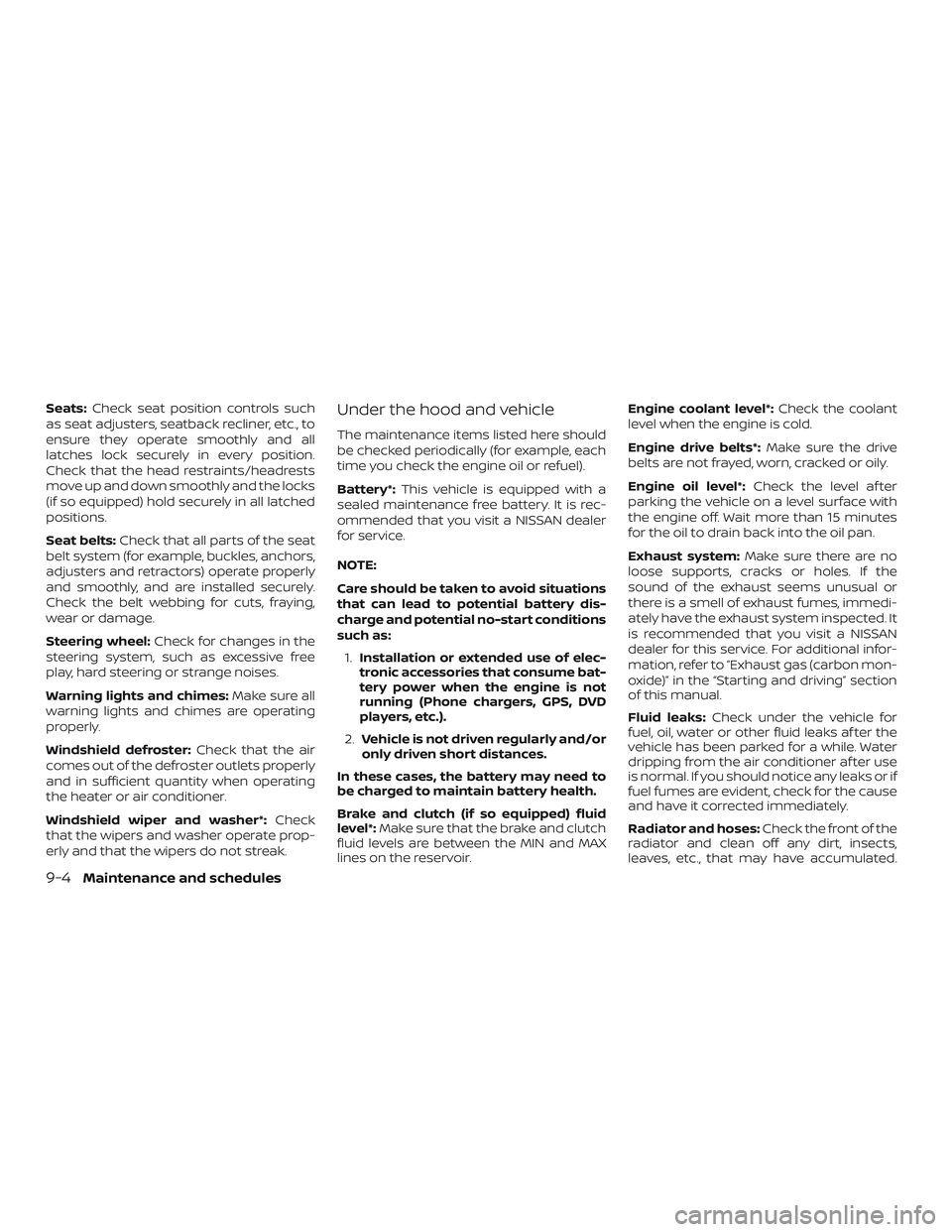
Seats:Check seat position controls such
as seat adjusters, seatback recliner, etc., to
ensure they operate smoothly and all
latches lock securely in every position.
Check that the head restraints/headrests
move up and down smoothly and the locks
(if so equipped) hold securely in all latched
positions.
Seat belts: Check that all parts of the seat
belt system (for example, buckles, anchors,
adjusters and retractors) operate properly
and smoothly, and are installed securely.
Check the belt webbing for cuts, fraying,
wear or damage.
Steering wheel: Check for changes in the
steering system, such as excessive free
play, hard steering or strange noises.
Warning lights and chimes: Make sure all
warning lights and chimes are operating
properly.
Windshield defroster: Check that the air
comes out of the defroster outlets properly
and in sufficient quantity when operating
the heater or air conditioner.
Windshield wiper and washer*: Check
that the wipers and washer operate prop-
erly and that the wipers do not streak.Under the hood and vehicle
The maintenance items listed here should
be checked periodically (for example, each
time you check the engine oil or refuel).
Battery*: This vehicle is equipped with a
sealed maintenance free battery. It is rec-
ommended that you visit a NISSAN dealer
for service.
NOTE:
Care should be taken to avoid situations
that can lead to potential battery dis-
charge and potential no-start conditions
such as:
1. Installation or extended use of elec-
tronic accessories that consume bat-
tery power when the engine is not
running (Phone chargers, GPS, DVD
players, etc.).
2. Vehicle is not driven regularly and/or
only driven short distances.
In these cases, the battery may need to
be charged to maintain battery health.
Brake and clutch (if so equipped) fluid
level*: Make sure that the brake and clutch
fluid levels are between the MIN and MAX
lines on the reservoir. Engine coolant level*:
Check the coolant
level when the engine is cold.
Engine drive belts*: Make sure the drive
belts are not frayed, worn, cracked or oily.
Engine oil level*: Check the level af ter
parking the vehicle on a level surface with
the engine off. Wait more than 15 minutes
for the oil to drain back into the oil pan.
Exhaust system: Make sure there are no
loose supports, cracks or holes. If the
sound of the exhaust seems unusual or
there is a smell of exhaust fumes, immedi-
ately have the exhaust system inspected. It
is recommended that you visit a NISSAN
dealer for this service. For additional infor-
mation, refer to “Exhaust gas (carbon mon-
oxide)” in the “Starting and driving” section
of this manual.
Fluid leaks: Check under the vehicle for
fuel, oil, water or other fluid leaks af ter the
vehicle has been parked for a while. Water
dripping from the air conditioner af ter use
is normal. If you should notice any leaks or if
fuel fumes are evident, check for the cause
and have it corrected immediately.
Radiator and hoses: Check the front of the
radiator and clean off any dirt, insects,
leaves, etc., that may have accumulated.
9-4Maintenance and schedules
Page 475 of 492
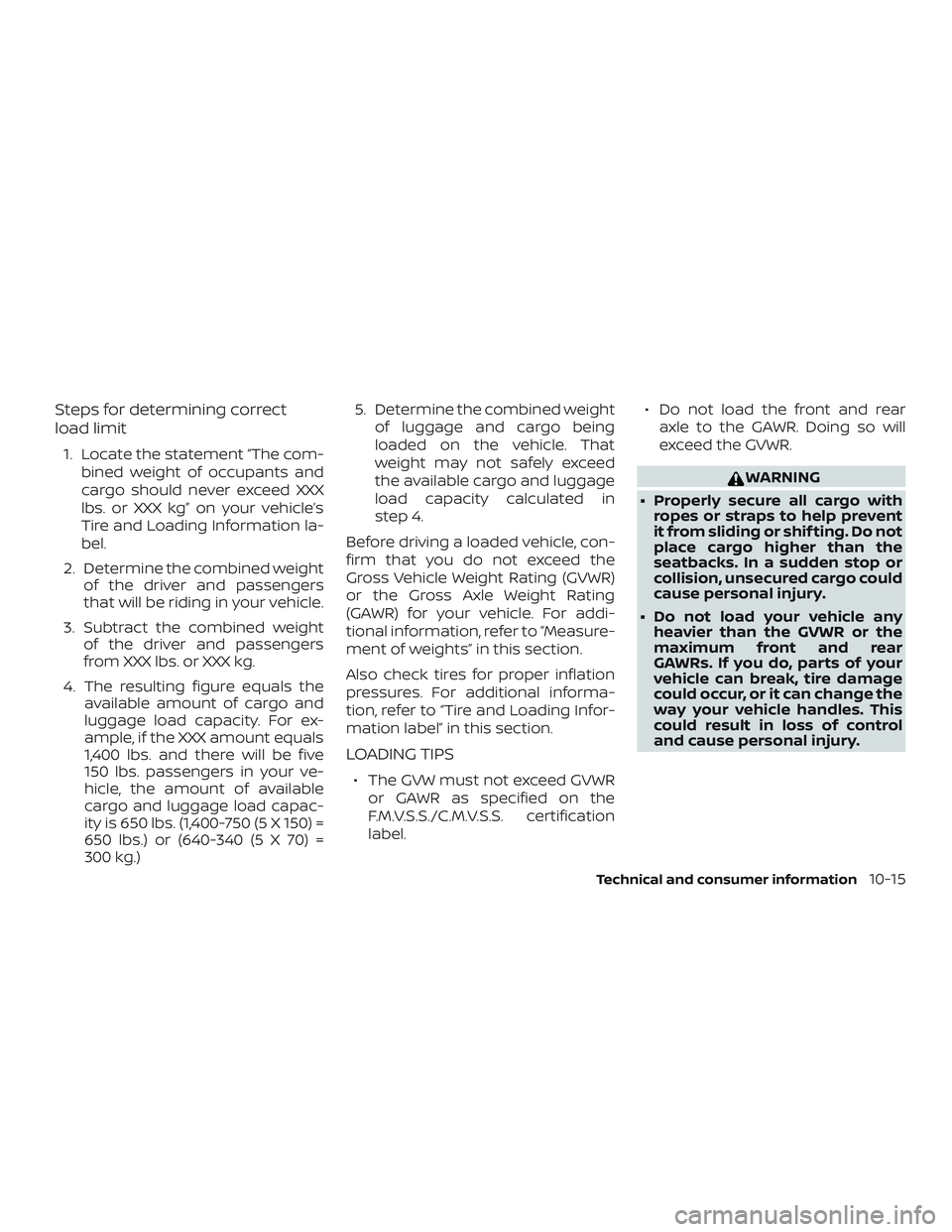
Steps for determining correct
load limit
1. Locate the statement “The com-bined weight of occupants and
cargo should never exceed XXX
lbs. or XXX kg” on your vehicle’s
Tire and Loading Information la-
bel.
2. Determine the combined weight of the driver and passengers
that will be riding in your vehicle.
3. Subtract the combined weight of the driver and passengers
from XXX lbs. or XXX kg.
4. The resulting figure equals the available amount of cargo and
luggage load capacity. For ex-
ample, if the XXX amount equals
1,400 lbs. and there will be five
150 lbs. passengers in your ve-
hicle, the amount of available
cargo and luggage load capac-
ity is 650 lbs. (1,400-750 (5 X 150) =
650 lbs.) or (640-340 (5 X 70) =
300 kg.) 5. Determine the combined weight
of luggage and cargo being
loaded on the vehicle. That
weight may not safely exceed
the available cargo and luggage
load capacity calculated in
step 4.
Before driving a loaded vehicle, con-
firm that you do not exceed the
Gross Vehicle Weight Rating (GVWR)
or the Gross Axle Weight Rating
(GAWR) for your vehicle. For addi-
tional information, refer to “Measure-
ment of weights” in this section.
Also check tires for proper inflation
pressures. For additional informa-
tion, refer to “Tire and Loading Infor-
mation label” in this section.
LOADING TIPS
∙ The GVW must not exceed GVWR or GAWR as specified on the
F.M.V.S.S./C.M.V.S.S. certification
label. ∙ Do not load the front and rear
axle to the GAWR. Doing so will
exceed the GVWR.
WARNING
∙ Properly secure all cargo with ropes or straps to help prevent
it from sliding or shif ting. Do not
place cargo higher than the
seatbacks. In a sudden stop or
collision, unsecured cargo could
cause personal injury.
∙ Do not load your vehicle any heavier than the GVWR or the
maximum front and rear
GAWRs. If you do, parts of your
vehicle can break, tire damage
could occur, or it can change the
way your vehicle handles. This
could result in loss of control
and cause personal injury.
Technical and consumer information10-15
Page 476 of 492
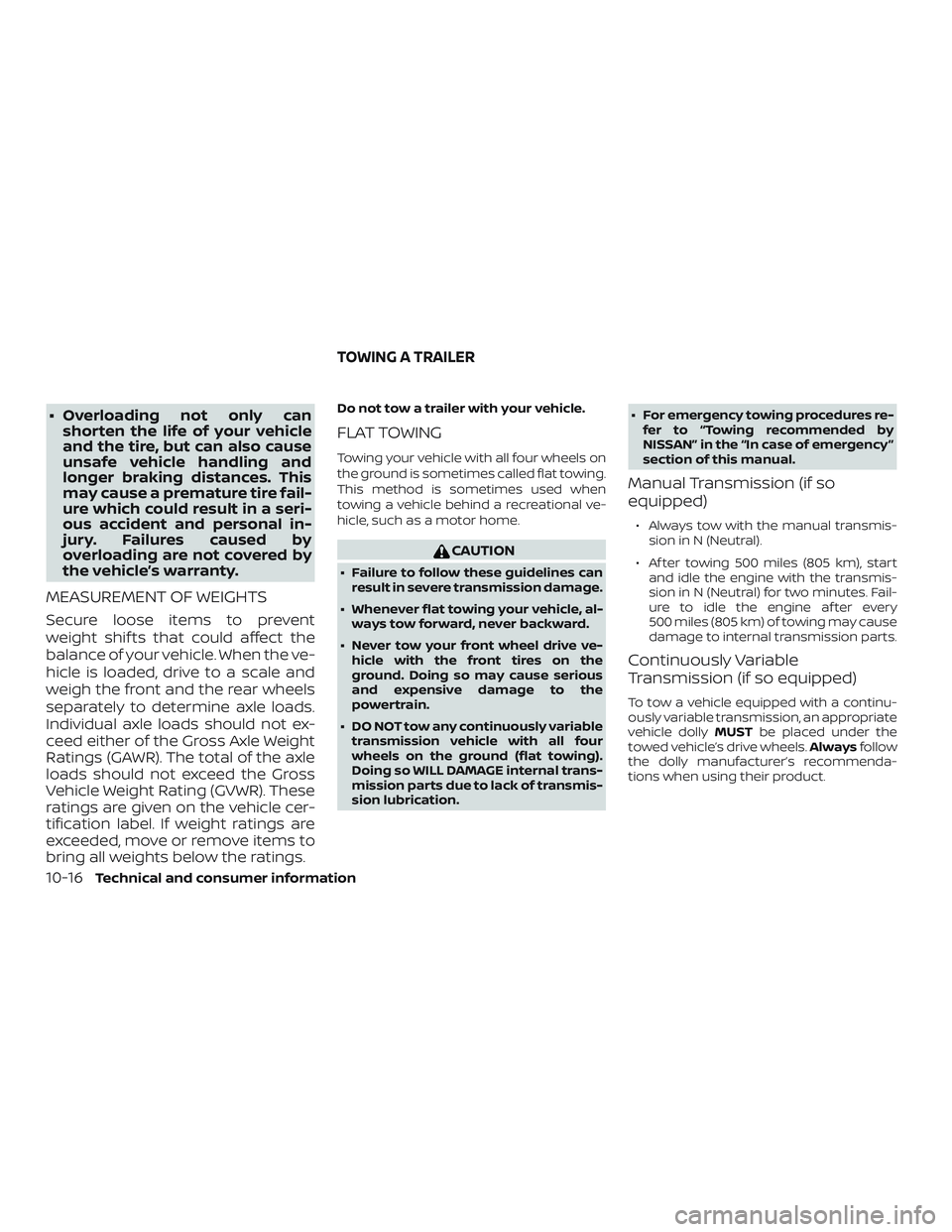
∙ Overloading not only canshorten the life of your vehicle
and the tire, but can also cause
unsafe vehicle handling and
longer braking distances. This
may cause a premature tire fail-
ure which could result in a seri-
ous accident and personal in-
jury. Failures caused by
overloading are not covered by
the vehicle’s warranty.
MEASUREMENT OF WEIGHTS
Secure loose items to prevent
weight shif ts that could affect the
balance of your vehicle. When the ve-
hicle is loaded, drive to a scale and
weigh the front and the rear wheels
separately to determine axle loads.
Individual axle loads should not ex-
ceed either of the Gross Axle Weight
Ratings (GAWR). The total of the axle
loads should not exceed the Gross
Vehicle Weight Rating (GVWR). These
ratings are given on the vehicle cer-
tification label. If weight ratings are
exceeded, move or remove items to
bring all weights below the ratings.
Do not tow a trailer with your vehicle.
FLAT TOWING
Towing your vehicle with all four wheels on
the ground is sometimes called flat towing.
This method is sometimes used when
towing a vehicle behind a recreational ve-
hicle, such as a motor home.
CAUTION
∙ Failure to follow these guidelines can
result in severe transmission damage.
∙ Whenever flat towing your vehicle, al- ways tow forward, never backward.
∙ Never tow your front wheel drive ve- hicle with the front tires on the
ground. Doing so may cause serious
and expensive damage to the
powertrain.
∙ DO NOT tow any continuously variable transmission vehicle with all four
wheels on the ground (flat towing).
Doing so WILL DAMAGE internal trans-
mission parts due to lack of transmis-
sion lubrication. ∙ For emergency towing procedures re-
fer to “Towing recommended by
NISSAN” in the “In case of emergency ”
section of this manual.
Manual Transmission (if so
equipped)
∙ Always tow with the manual transmis- sion in N (Neutral).
∙ Af ter towing 500 miles (805 km), start and idle the engine with the transmis-
sion in N (Neutral) for two minutes. Fail-
ure to idle the engine af ter every
500 miles (805 km) of towing may cause
damage to internal transmission parts.
Continuously Variable
Transmission (if so equipped)
To tow a vehicle equipped with a continu-
ously variable transmission, an appropriate
vehicle dolly MUSTbe placed under the
towed vehicle’s drive wheels. Alwaysfollow
the dolly manufacturer’s recommenda-
tions when using their product.
TOWING A TRAILER
10-16Technical and consumer information
Page 479 of 492
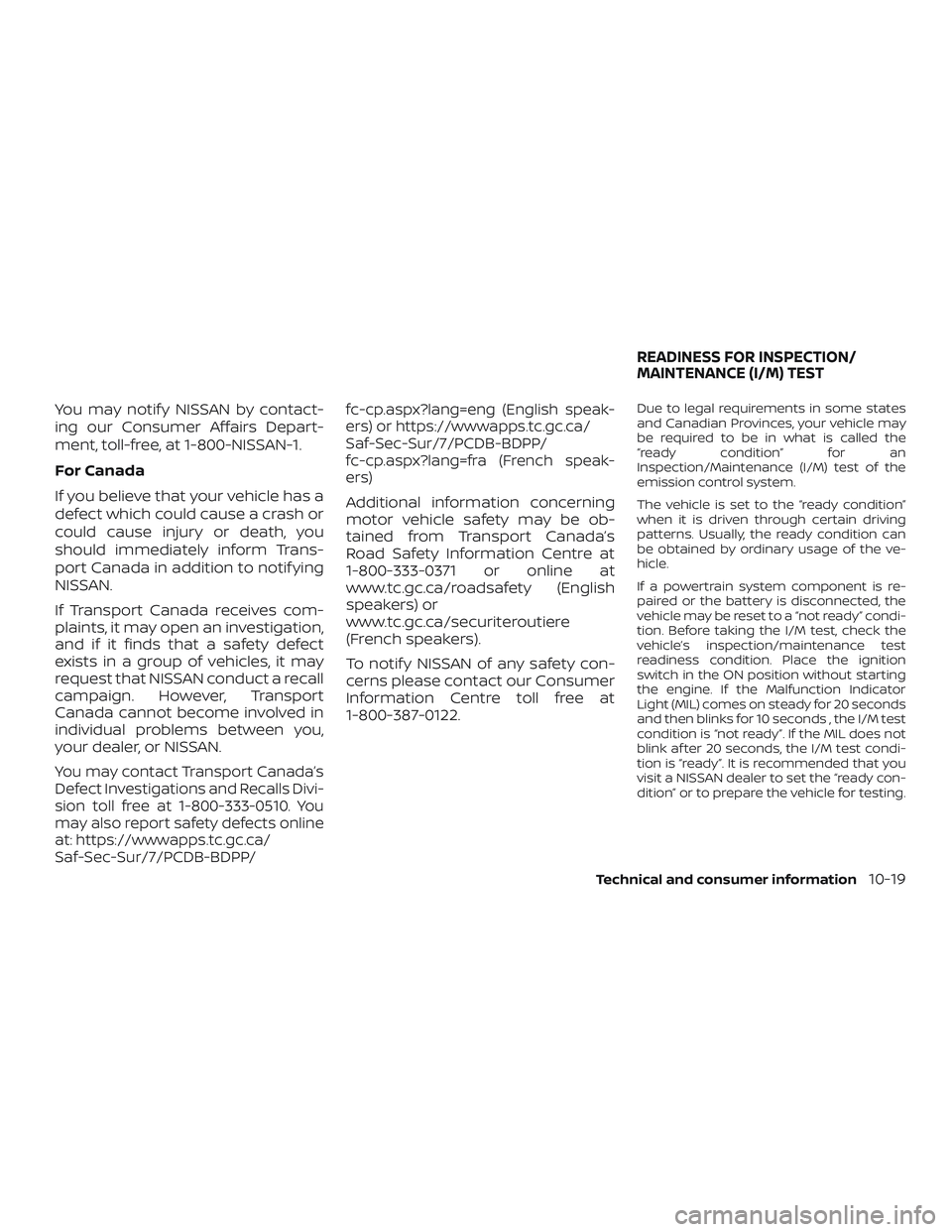
You may notif y NISSAN by contact-
ing our Consumer Affairs Depart-
ment, toll-free, at 1-800-NISSAN-1.
For Canada
If you believe that your vehicle has a
defect which could cause a crash or
could cause injury or death, you
should immediately inform Trans-
port Canada in addition to notif ying
NISSAN.
If Transport Canada receives com-
plaints, it may open an investigation,
and if it finds that a safety defect
exists in a group of vehicles, it may
request that NISSAN conduct a recall
campaign. However, Transport
Canada cannot become involved in
individual problems between you,
your dealer, or NISSAN.
You may contact Transport Canada’s
Defect Investigations and Recalls Divi-
sion toll free at 1-800-333-0510. You
may also report safety defects online
at: https://wwwapps.tc.gc.ca/
Saf-Sec-Sur/7/PCDB-BDPP/fc-cp.aspx?lang=eng (English speak-
ers) or https://wwwapps.tc.gc.ca/
Saf-Sec-Sur/7/PCDB-BDPP/
fc-cp.aspx?lang=fra (French speak-
ers)
Additional information concerning
motor vehicle safety may be ob-
tained from Transport Canada’s
Road Safety Information Centre at
1-800-333-0371 or online at
www.tc.gc.ca/roadsafety (English
speakers) or
www.tc.gc.ca/securiteroutiere
(French speakers).
To notif y NISSAN of any safety con-
cerns please contact our Consumer
Information Centre toll free at
1-800-387-0122.
Due to legal requirements in some states
and Canadian Provinces, your vehicle may
be required to be in what is called the
“ready condition” for an
Inspection/Maintenance (I/M) test of the
emission control system.
The vehicle is set to the “ready condition”
when it is driven through certain driving
patterns. Usually, the ready condition can
be obtained by ordinary usage of the ve-
hicle.
If a powertrain system component is re-
paired or the battery is disconnected, the
vehicle may be reset to a “not ready” condi-
tion. Before taking the I/M test, check the
vehicle’s inspection/maintenance test
readiness condition. Place the ignition
switch in the ON position without starting
the engine. If the Malfunction Indicator
Light (MIL) comes on steady for 20 seconds
and then blinks for 10 seconds , the I/M test
condition is “not ready”. If the MIL does not
blink af ter 20 seconds, the I/M test condi-
tion is “ready”. It is recommended that you
visit a NISSAN dealer to set the “ready con-
dition” or to prepare the vehicle for testing.
READINESS FOR INSPECTION/
MAINTENANCE (I/M) TEST
Technical and consumer information10-19
Page 481 of 492
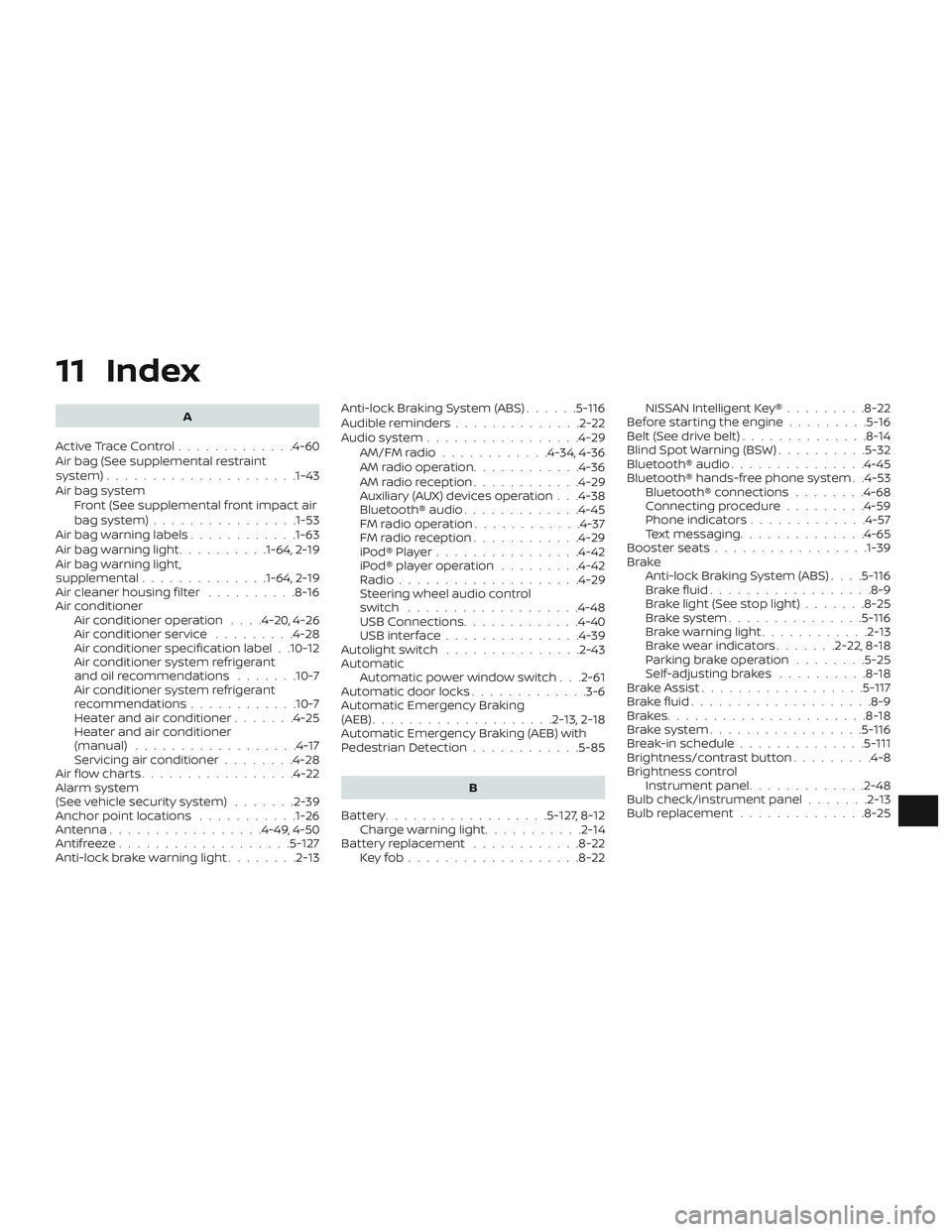
11 Index
A
ActiveTraceControl.............4-60
Air bag (See supplemental restraint
system) .................... .1-43
Air bag system Front (See supplemental front impact air
bagsystem)............... .1-53
Air bag warning labels ............1-63
Airbagwarninglight..........1-64, 2-19
Air bag warning light,
supplemental ..............1-64, 2-19
Air cleaner housing filter ..........8-16
Air conditioner Air conditioner operation ....4-20,4-26
Air conditioner service .........4-28
Air conditioner specification label . .10-12
Air conditioner system refrigerant
and oil recommendations .......10-7
Air conditioner system refrigerant
recommendations ............10-7
Heater and air conditioner .......4-25
Heater and air conditioner
(manual) ..................4-17
Servicing air conditioner ........4-28
Air flow charts .................4-22
Alarm system
(See vehicle security system) .......2-39
Anchor point locations ...........1-26
Antenna .................4-49,4-50
Antifreeze ...................5-127
Anti-lock brake warning light ........2-13Anti-lock Braking System (ABS)
......5-116
Audible reminders ..............2-22
Audiosystem.................4-29 AM/FMradio............4-34,4-36
AM radio operation ............4-36
AMradioreception............4-29
Auxiliary (AUX) devices operation . . .4-38
Bluetooth® audio .............4-45
FM radio operation ............4-37
FMradioreception............4-29
iPod®Player................4-42
iPod® player operation .........4-42
Radio ....................4-29
Steering wheel audio control
switch ...................4-48
USB Connections .............4-40
USBinterface...............4-39
Autolightswitch ...............2-43
Automatic Automatic power window switch . . .2-61
Automatic door locks .............3-6
Automatic Emergency Braking
(AEB) ....................2-13,2-18
Automatic Emergency Braking (AEB) with
Pedestrian Detection ............5-85
B
Battery..................5-127,8-12 Charge warning light ...........2-14
Battery replacement ............8-22
Keyfob...................8-22 NISSAN Intelligent Key®
.........8-22
Before starting the engine .........5-16
Belt(Seedrivebelt)..............8-14
Blind Spot Warning (BSW) ..........5-32
Bluetooth® audio ...............4-45
Bluetooth® hands-free phone system . .4-53 Bluetooth® connections ........4-68
Connecting procedure .........4-59
Phone indicators .............4-57
Text messaging ..............4-65
Booster seats .................1-39
Br ak
e
Anti-lock Braking System (ABS) ....5-116
Brakefluid..................8-9
Brakelight(Seestoplight).......8-25
Brakesystem...............5-116
Brakewarninglight............2-13
Brakewearindicators.......2-22, 8-18
Parking brake operation ........5-25
Self-adjustingbrakes ..........8-18
Brake Assist ..................5-117
Brakefluid....................8-9
Brakes......................8-18
Brakesystem.................5 -116
Break-in schedule ..............5-111
Brightness/contrast button .........4-8
Brightness control Instrument panel .............2-48
Bulb check/instrument panel .......2-13
Bulb replacement ..............8-25
Page 484 of 492
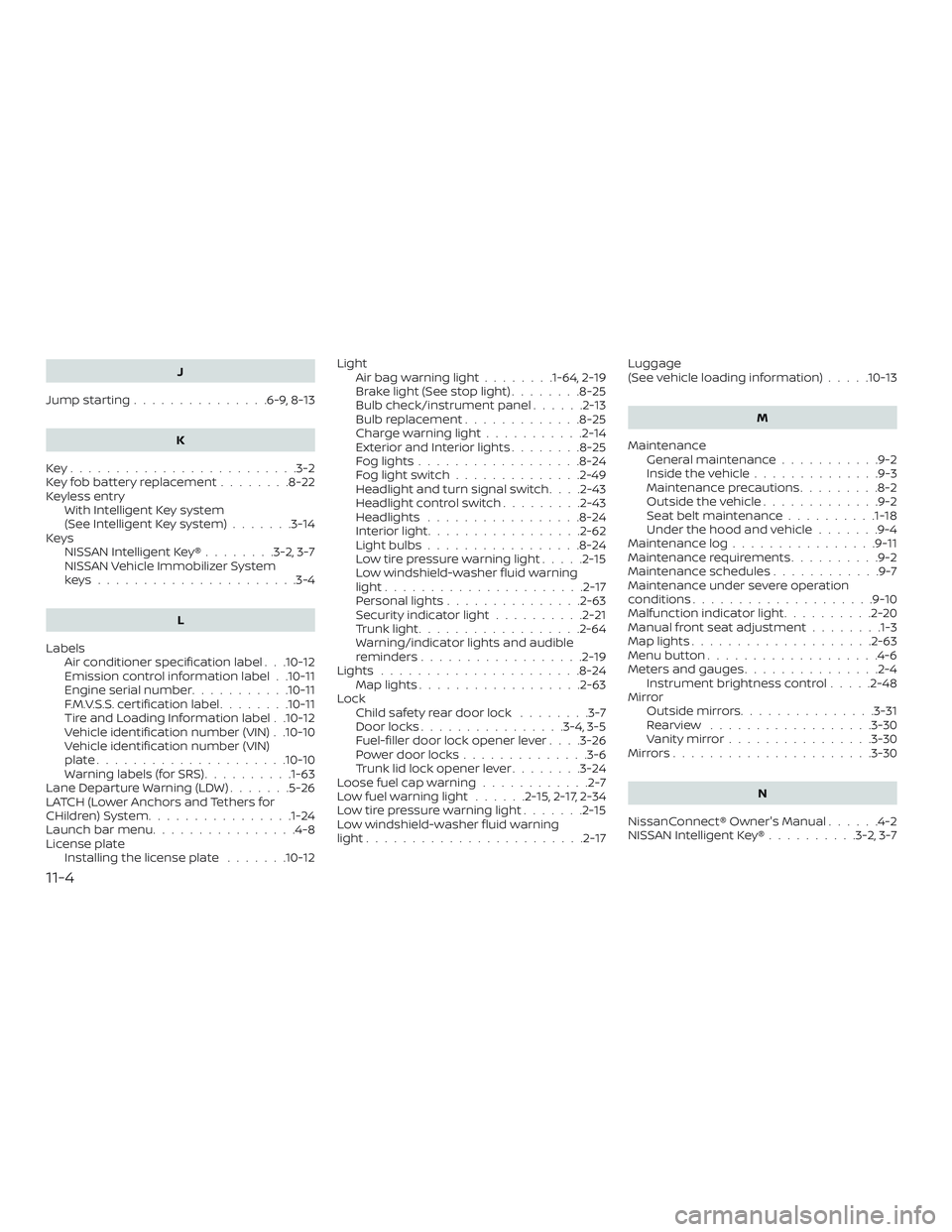
J
Jumpstarting...............6-9,8-13
K
Key.........................3-2
Key fob battery replacement ........8-22
Keyless entry With Intelligent Key system
(See Intelligent Key system) .......3-14
Keys NISSAN Intelligent Key® ........3-2,3-7
NISSAN Vehicle Immobilizer System
keys......................3-4
L
Labels Air conditioner specification label . . .10-12
Emission control information label . .10-11
Engine serial number ...........10-11
F.M.V.S.S. certification label ........10-11
Tire and Loading Information label . .10-12
Vehicle identification number (VIN) . .10-10
Vehicle identification number (VIN)
plate.....................10-10
Warning labels (for SRS) ..........1-63
Lane Departure Warning (LDW) .......5-26
LATCH (Lower Anchors and Tethers for
CHildren)System............... .1-24
Launch bar menu ................4-8
License plate Installing the license plate .......10-12Light
Airbagwarninglight........1-64, 2-19
Brakelight(Seestoplight)........8-25
Bulb check/instrument panel ......2-13
Bulb replacement .............8-25
Charge warning light ...........2-14
ExteriorandInteriorlights........8-25
Foglights..................8-24
Foglightswitch..............2-49
Headlight and turn signal switch ....2-43
Headlightcontrolswitch.........2-43
Headlights .................8-24
Interiorlight.................2-62
Lightbulbs.................8-24
Low tire pressure warning light .....2-15
Low windshield-washer fluid warning
light......................2-17
Personal lights ...............2-63
Security indicator light ..........2-21
Trunklight..................2-64
Warning/indicator lights and audible
reminders ..................2-19
Lights......................8-24 Maplights..................2-63
Lock Child safety rear door lock ........3-7
Door locks ................3-4,3-5
Fuel-filler door lock opener lever . . . .3-26
Power door locks ..............3-6
Trunk lid lock opener lever ........3-24
Loose fuel cap warning ............2-7
Lowfuelwarninglight......2-15,2-17,2-34
Low tire pressure warning light .......2-15
Low windshield-washer fluid warning
light........................2-17 Luggage
(See vehicle loading information)
.....10-13
M
Maintenance General maintenance ...........9-2
Insidethevehicle..............9-3
Maintenance precautions .........8-2
Outsidethevehicle.............9-2
Seat belt maintenance ..........1-18
Under the hood and vehicle .......9-4
Maintenance log ................9-11
Maintenance requirements ..........9-2
Maintenance schedules ............9-7
Maintenance under severe operation
conditions....................9-10
Malfunctionindicatorlight..........2-20
Manual front seat adjustment ........1-3
Maplights................... .2-63
Menu button ...................4-6
Meters and gauges ...............2-4
Instrument brightness control .....2-48
Mirror Outsidemirrors...............3-31
Rearview ..................3-30
Va
nitymirror................3-30
Mirrors......................3-30
N
NissanConnect® Owner's Manual ......4-2
NISSAN Intelligent Key® ..........3-2,3-7
11-4
Page 486 of 492
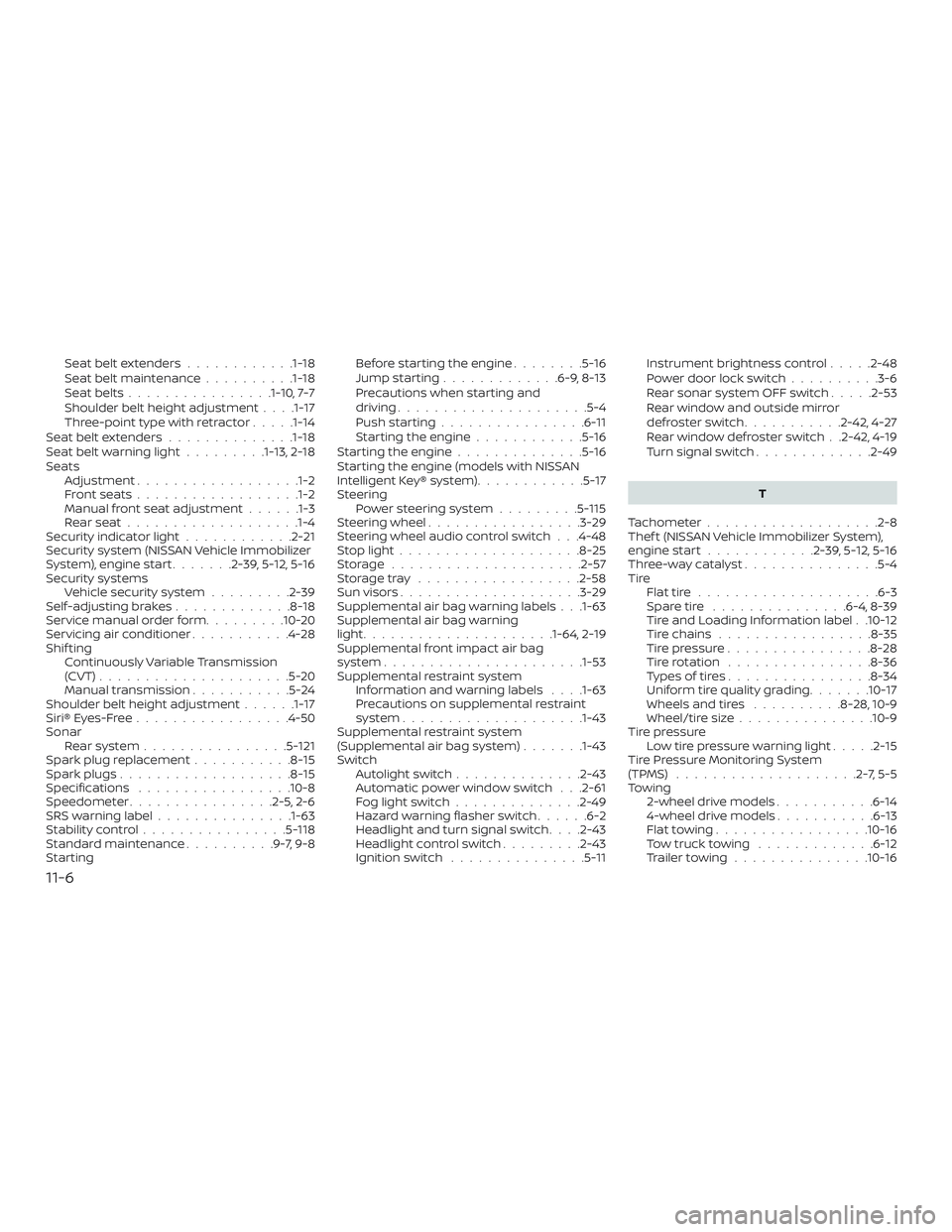
Seat belt extenders............1-18
Seat belt maintenance ..........1-18
Seatbelts................1-10, 7-7
Shoulder belt height adjustment . . . .1-17
Three-pointtypewithretractor.....1-14
Seat belt extenders ..............1-18
Seatbeltwarninglight.........1-13, 2-18
Seats Adjustment ..................1-2
Frontseats..................1-2
Manual front seat adjustment ......1-3
Rearseat...................1-4
Security indicator light ............2-21
Security system (NISSAN Vehicle Immobilizer
System), engine start .......2-39,5-12,5-16
Security systems Vehicle security system .........2-39
Self-adjustingbrakes.............8-18
Service manual order form .........10-20
Servicing air conditioner ...........4-28
Shif ting Continuously Variable Transmission
(CVT) .....................5-20
Manual transmission ...........5-24
Shoulder belt height adjustment ......1-17
Siri® Eyes-Free .................4-50
Sonar Rear system ................5-121
Spark plug replacement ...........8-15
Spark plugs ...................8-15
Specifications .................10-8
Speedometer ................2-5,2-6
SRS warning label ...............1-63
Stability control ................5 -118
Standard maintenance ..........9-7,9-8
Starting Before starting the engine
........5-16
Jumpstarting.............6-9,8-13
Precautions when starting and
driving.....................5-4
Push starting ................6-11
Starting the engine ............5-16
Starting the engine ..............5-16
Starting the engine (models with NISSAN
Intelligent Key® system) ............5-17
Steering Powersteeringsystem.........5 -115
Steering wheel .................3-29
Steering wheel audio control switch . . .4-48
Stoplight....................8-25
Storage .....................2-57
Storagetray ..................2-58
Sunvisors....................3-29
Supplemental air bag warning labels . . .1-63
Supplemental air bag warning
light.....................1-64, 2-19
Supplemental front impact air bag
system ..................... .1-53
Supplemental restraint system Information and warning labels . . . .1-63
Precautions on supplemental restraint
system ....................1-43
Supplemental restraint system
(Supplemental air bag system) .......1-43
Switch Autolightswitch..............2-43
Automatic power window switch . . .2-61
Fo
glightswitch..............2-49
Hazard warning flasher switch ......6-2
Headlight and turn signal switch ....2-43
Headlightcontrolswitch.........2-43
Ignition switch ...............5-11 Instrument brightness control
.....2-48
Power door lock switch ..........3-6
Rear sonar system OFF switch .....2-53
Rear window and outside mirror
defrosterswitch...........2-42,4-27
Rear window defroster switch . .2-42, 4-19
Turn signal switch .............2-49
T
Tachometer ...................2-8
Thef t (NISSAN Vehicle Immobilizer System),
engine start ............2-39,5-12,5-16
Three-waycatalyst...............5-4
Tire Flattire....................6-3
Spare tire ...............6-4,8-39
Tire and Loading Information label . .10-12
Tire chains .................8-35
Tire pressure ................8-28
Tirerotation ................8-36
Types of tires ................8-34
Uniform tire quality grading .......10-17
Wheels and tires ..........8-28,10-9
Wheel/tire size ...............10-9
Tire pressure Low tire pressure warning light .....2-15
Tire Pressure Monitoring System
(TPMS) ....................2-7, 5-5
Towing 2-wheel drive models ...........6-14
4-wheel drive models ...........6-13
Flattowing.................10-16
Towtrucktowing .............6-12
Trailertowing...............10-16
11-6
Page 487 of 492
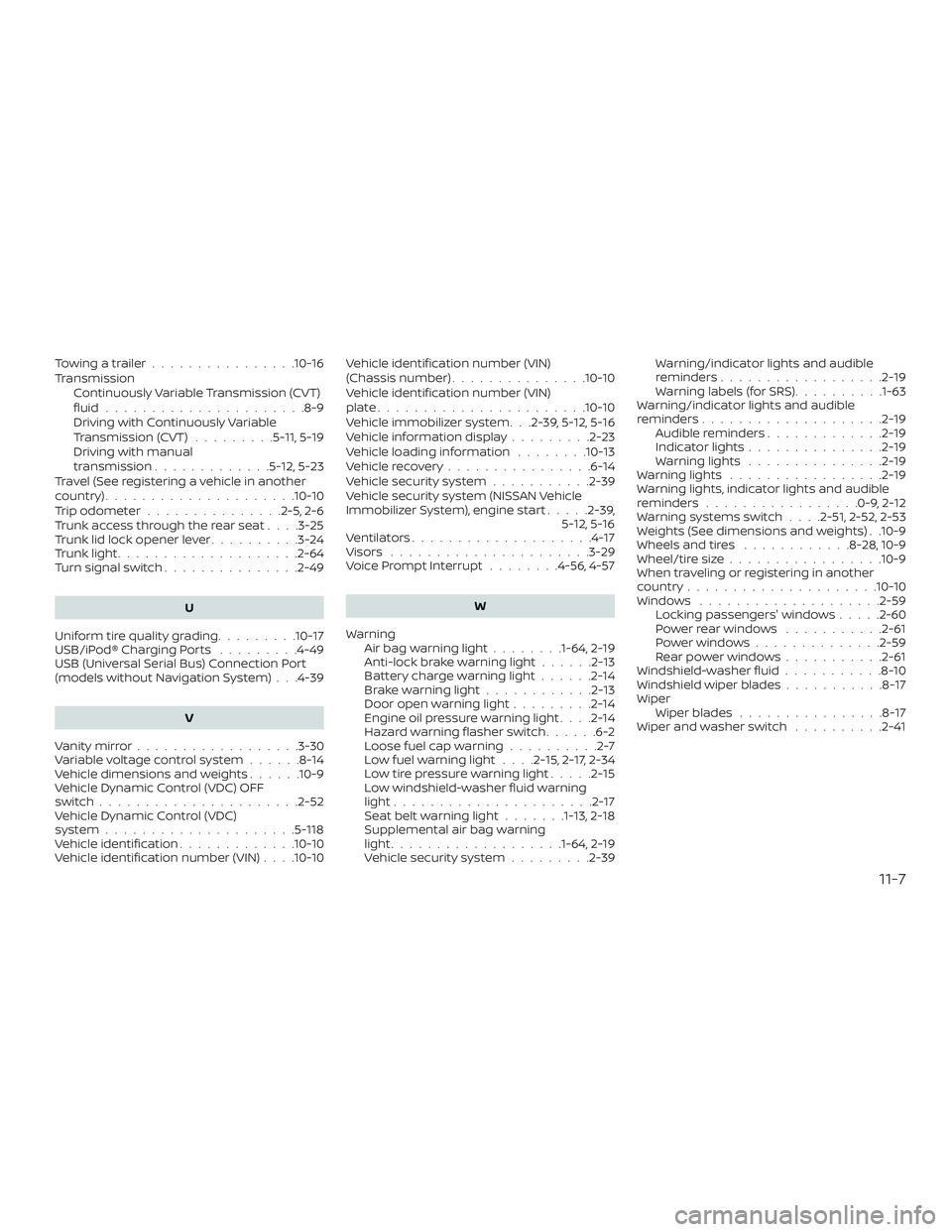
Towingatrailer................10-16
TransmissionContinuously Variable Transmission (CVT)
fluid......................8-9
Driving with Continuously Variable
Transmission (CVT) .........5-11, 5-19
Driving with manual
transmission .............5-12,5-23
Travel (See registering a vehicle in another
country) .....................10-10
Trip odometer ...............2-5,2-6
Trunk access through the rear seat ....3-25
Trunk lid lock opener lever ..........3-24
Trunklight....................2-64
Turn signal switch ...............2-49
U
Uniform tire quality grading .........10-17
USB/iPod® Charging Ports .........4-49
USB (Universal Serial Bus) Connection Port
(models without Navigation System) . . .4-39
V
Vanitymirror..................3-30
Variable voltage control system ......8-14
Vehicle dimensions and weights ......10-9
Vehicle Dynamic Control (VDC) OFF
switch......................2-52
Vehicle Dynamic Control (VDC)
system .....................5 -118
Vehicle identification .............10-10
Vehicle identification number (VIN) . . . .10-10Vehicle identification number (VIN)
(Chassis number)
...............10-10
Vehicle identification number (VIN)
plate.......................10-10
Vehicle immobilizer system. . .2-39, 5-12, 5-16
Vehicleinformationdisplay.........2-23
Vehicle loading information ........10-13
Vehiclerecovery................6-14
Vehicle security system ...........2-39
Vehicle security system (NISSAN Vehicle
Immobilizer System), engine start .....2-39,
5-12, 5-16
Ventilators ....................4-17
Visors ......................3-29
Voice Prompt Interrupt ........4-56,4-57
W
Warning Airbagwarninglight........1-64, 2-19
Anti-lock brake warning light ......2-13
Battery charge warning light ......2-14
Brakewarninglight............2-13
Door open warning light .........2-14
Engine oil pressure warning light ....2-14
Hazard warning flasher switch ......6-2
Loose fuel cap warning ..........2-7
Lowfuelwarninglight....2-15,2-17,2-34
Lowtirepressurewarninglight.....2-15
Low windshield-washer fluid warning
light......................2-17
Seatbeltwarninglight.......1-13, 2-18
Supplemental air bag warning
light...................1-64, 2-19
Vehicle security system .........2-39Warning/indicator lights and audible
reminders
..................2-19
Warning labels (for SRS) ..........1-63
Warning/indicator lights and audible
reminders ....................2-19
Audible reminders .............2-19
Indicatorlights...............2-19
Warninglights ...............2-19
Warninglights .................2-19
Warning lights, indicator lights and audible
reminders .................0-9,2-12
Warningsystemsswitch....2-51,2-52,2-53
Weights (See dimensions and weights) . .10-9
Wheels and tires ............8-28,10-9
Wheel/tire size .................10-9
When traveling or registering in another
country .....................10-10
Windows ....................2-59 Locking passengers' windows .....2-60
Powerrearwindows ...........2-61
Powerwindows............. .2-59
Rearpowerwindows.......... .2-61
Windshield -washer
fluid ...........8-10
Windshield wiper blades ...........8-17
Wiper Wiper blades ................8-17
Wiper and washer switch ..........2-41
11-7